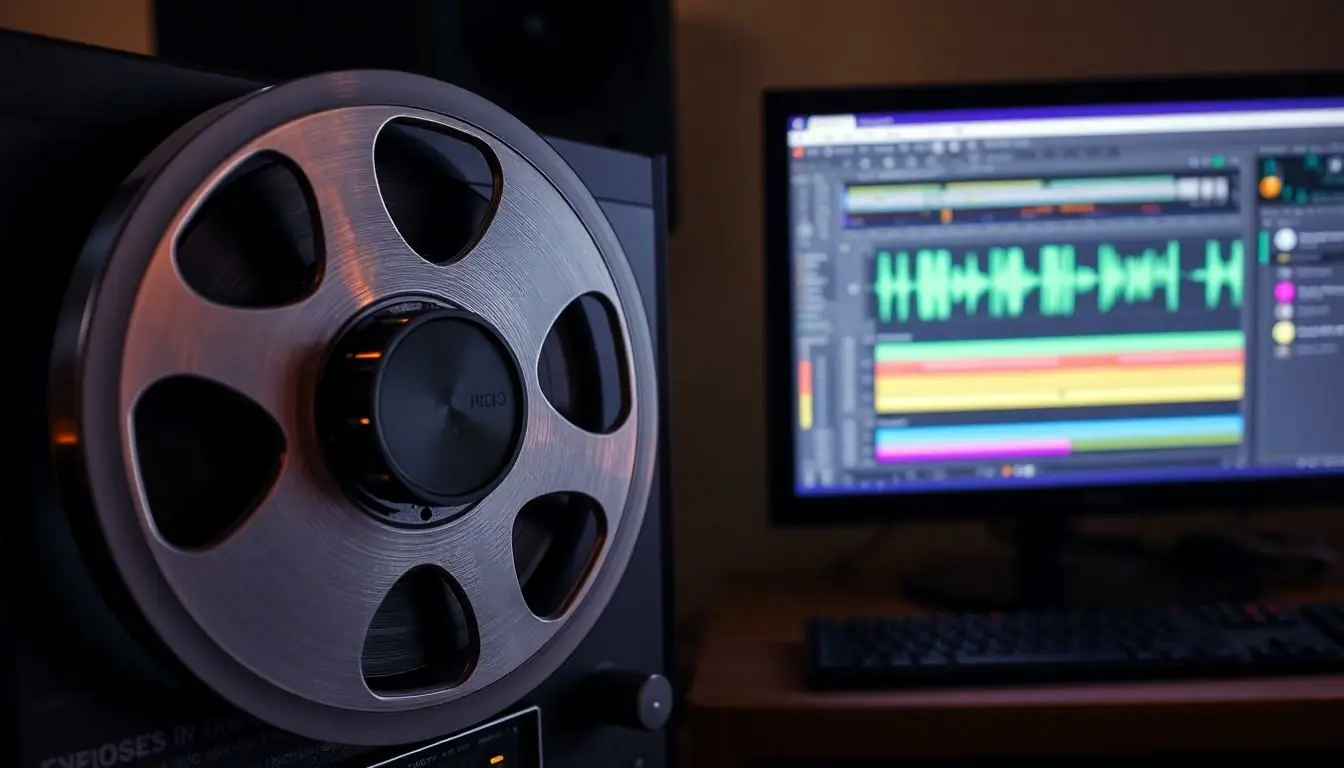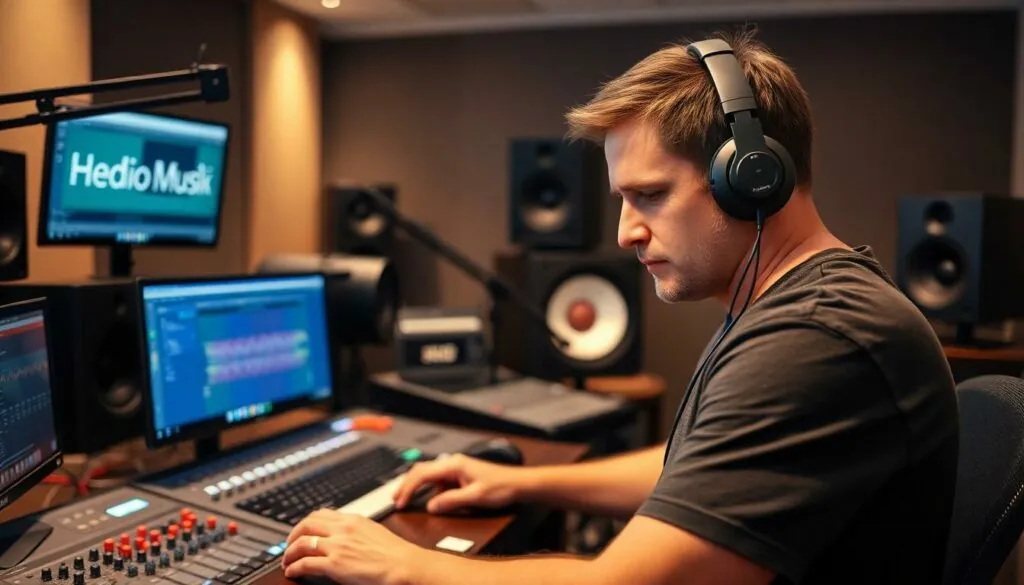Table of Contents
ToggleIn a world where everyone’s a budding podcaster or a bedroom musician, audio recording technology has become the unsung hero of creativity. It’s like having a magic wand that transforms everyday sounds into masterpieces. Whether it’s capturing the perfect vocal take or crafting a soundscape that’ll make listeners weep, the right gear can turn anyone into a sonic wizard.
Overview of Audio Recording Technology
Audio recording technology encompasses various tools and techniques that transform sound into digital formats. It plays a critical role in numerous fields such as music production, podcasting, and film. Users rely on microphones, audio interfaces, and software to capture and manipulate sound waves effectively.
Microphones serve as the primary input device for audio recording. Dynamic, condenser, and ribbon microphones offer unique characteristics, catering to different recording needs. Each type excels in specific scenarios, such as live performances or studio sessions.
Audio interfaces convert analog signals into digital data, facilitating high-quality recordings. They connect microphones and instruments to computers, ensuring clear sound capture. Various models exist, ranging from entry-level options to professional-grade interfaces with multiple inputs and outputs.
Digital audio workstations (DAWs) represent key software for editing and producing audio. DAWs enable users to manipulate recorded sounds, add effects, and mix tracks seamlessly. Popular examples include Pro Tools, Logic Pro, and Ableton Live, each boasting unique features tailored to different workflows.
Advancements in technology continue to shape the audio landscape. Innovations in mobile recording devices enhance portability, allowing creators to capture sounds anywhere. Cloud storage solutions provide convenience for storing and sharing audio projects, streamlining collaboration among artists.
Furthermore, audiophiles and professionals benefit from high-resolution audio formats. These formats elevate sound quality, enhancing listening experiences in music and film. Technologies such as lossless compression and spatial audio contribute to immersive soundscapes, pushing the boundaries of audio playback.
Developments in artificial intelligence also influence audio recording techniques. AI-driven tools assist in music composition, sound editing, and voice enhancement, further expanding creative possibilities. The integration of AI into audio recording technology facilitates more efficient and innovative production processes.
Types of Audio Recording Technology

Audio recording technology encompasses various methods to capture sound. Two primary types, analog and digital, represent distinct approaches to audio recording.
Analog Recording
Analog recording captures sound through continuous waveforms. In this method, devices like reel-to-reel tape recorders convert acoustic energy into electrical signals. Magnetic tape retains these signals, providing a warm, natural sound profile. Artists often appreciate the charm of analog recordings for their unique tonal qualities. Equipment such as vinyl records and cassette tapes utilizes similar principles. Each device contributes to the distinctive character that defines many classic recordings.
Digital Recording
Digital recording relies on discrete samples of sound waves. Through an analog-to-digital converter, sound transforms into a series of numbers, enabling precise editing and manipulation. Digital audio workstations facilitate this process, allowing seamless integration of audio effects and virtual instruments. This technology ensures high fidelity, accommodating various formats for playback on multiple devices. Convenience and portability often characterize digital recording, enabling creators to capture and share their work easily. Popular tools like Pro Tools and Logic Pro lead in offering user-friendly interfaces for comprehensive audio production.
Key Components of Audio Recording Systems
Understanding the key components of audio recording systems helps creators choose the right tools for their projects. Each element plays a crucial role in achieving high-quality sound.
Microphones
Microphones capture sound and convert it into electrical signals. Different types serve various purposes: dynamic microphones excel in live settings, condenser microphones are sensitive and ideal for studio recordings, and ribbon microphones deliver a warm tone. Choosing the right microphone impacts the clarity and detail of recordings. For instance, condenser mics often capture vocals with precision, while dynamic ones handle loud sound sources well. Each type offers unique characteristics that affect sound quality and recording environment requirements.
Mixers
Mixers blend multiple audio signals and provide control over individual track levels. By adjusting volume, EQ, and effects, users create a balanced sound. Audio engineers rely on mixers in both live and studio settings. Many options are available, ranging from compact versions for home studios to large-format consoles in professional environments. Features like built-in effects processing can enhance creativity by enabling real-time adjustments. Overall, mixers facilitate a seamless workflow and enable precise control over the final sound.
Audio Interfaces
Audio interfaces convert analog signals into digital data, making them essential for computer-based recording setups. They connect microphones and instruments to computers, ensuring high-quality sound capture. Most interfaces include preamps to boost signal strength, minimizing noise. Devices vary in features such as input/output configurations, sample rates, and latency levels. Selecting an interface with appropriate specifications guarantees compatibility with recording software and hardware. High-quality audio interfaces improve the overall recording experience and enhance sound fidelity.
Recent Innovations in Audio Recording Technology
Innovations in audio recording technology expand creative possibilities and enhance the overall recording experience. Recent developments in software and hardware have transformed how users interact with sound.
Software Developments
Notable advancements in audio software include increased accessibility to powerful digital audio workstations (DAWs). New versions of popular DAWs, such as Cubase and Ableton Live, introduce user-friendly interfaces and innovative features like real-time collaboration. Real-time pitch correction and advanced audio analysis tools also streamline the editing process. Emerging plugins employ artificial intelligence to assist in music composition and sound engineering, providing suggestions on arrangements and effects. Cloud-based solutions allow users to access projects from multiple devices, enhancing convenience and flexibility.
Hardware Advancements
Significant improvements in audio hardware offer users higher fidelity and greater versatility. Recent microphones leverage new technology to capture sound with increased clarity and detail. Dynamic and condenser microphones now incorporate built-in preamps, further enhancing sound quality. Portable audio interfaces have become more compact without sacrificing performance, enabling recordings in various environments. Wireless technology facilitates seamless connections between microphones, mixers, and audio interfaces, minimizing clutter and increasing mobility. Additionally, advancements in monitoring headphones provide accurate audio representation, crucial for fine-tuning recordings.
Audio recording technology continues to shape the creative landscape by providing tools that empower artists and producers. As innovations emerge, they enhance both the quality and accessibility of audio production. The evolution from analog to digital has opened up new avenues for creativity, making it easier for individuals to capture and manipulate sound.
With a deeper understanding of the essential components and advancements in technology, creators can make informed decisions about their setups. The right combination of microphones, interfaces, and software can lead to remarkable audio experiences. As the industry evolves, embracing these technologies will enable artists to push boundaries and explore new sonic territories.

